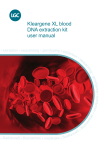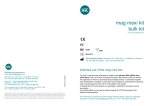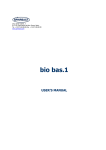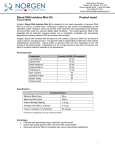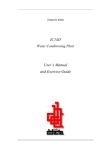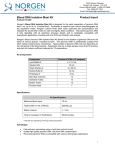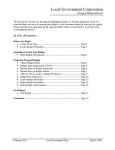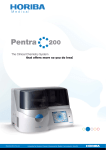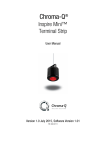Download Kleargene tissue plate DNA extraction kits user manual
Transcript
Kleargene tissue plate DNA extraction kits user manual • extraction • sequencing • genotyping • ex trac ti on •s eq ue nc in g •g eno typ ing • extr acti o n• s eq ue n c in g •g en o ty ping • extraction • sequencing • genotyping • Contents of this guide 1 Product description and specification 2 Kit contents 3 Reagent preparation 4 Safety information 5Protocol 5.1 Cell lysis 5.2 Absorption of DNA to glass fibre membranes 5.3 Contaminant removal through washing 5.4 Elution of purified DNA 6Notes 6.1 General points 6.2 Adapting the protocol to your laboratory 7Troubleshooting 8 Frequently asked questions 1. Product description and specification The Kleargene family are a series of kits designed to enable simple, rapid extraction and purification of genomic DNA from a variety of different sources. The Kleargene tissue plate kit is designed for the extraction of DNA from animal tissue. The method is based on the highly proven technology of detergent-driven cell lysis, followed by guanidinium isothiocyanate-mediated DNA binding to glass fibre membranes encapsulated in a filter plate. Contaminants are removed by washing and DNA is subsequently eluted into a low salt buffer. The entire process is carried out in one well per sample, and full 96-well plates of samples can be extracted in under an hour. For any queries on this manual or running KASP reactions in your laboratory please contact: All locations except USA: Email: [email protected] • Phone: +44 (0)1992 476 486 USA only: Email: [email protected] • Phone: +1 978 338 5317 2 2. Kit contents Component Storage1 KBS-1012-400 KBS-1012-401 KBS-1012-442 KBS-1012-443 Buffer T1 20-25°C 15 mL 60 mL 250 mL 1000 mL Buffer C1 20-25°C2 30 mL 125 mL 500 mL 2 x 1000 mL Buffer A1 20-25°C 15 mL 60 mL 250 mL 2 x 500 mL Buffer W1 20-25°C 4.5 mL 18 mL 75 mL 300 mL Buffer E1 20-25°C 15 mL 60 mL 250 mL 1000 mL Filter plate 20-25°C 1 x 96 4 x 96 16 x 96 64 x 96 Table 1: Contents of the Kleargene Tissue plate DNA extraction kit. 1 – before the required additional reagents are added to each buffer 2 – this should be stored in the dark To be supplied by the user Additional reagents • Ethanol • Isopropanol (propan-2-ol) • β-mercaptoethanol (2-mercaptoethanol) • Proteinase K (a stock solution should be made in an appropriate storage buffer). Equipment needed • Tissue homogenisation apparatus and consumables • Manual pipettes and disposable pipette tips OR a microplate dispensing robot • Polypropylene storage plates (and optionally ‘reservoir’ plates) • Fan oven • Waterbath incubator • Personal protective equipment (lab coat, gloves, goggles). For any queries on this manual or running KASP reactions in your laboratory please contact: All locations except USA: Email: [email protected] • Phone: +44 (0)1992 476 486 USA only: Email: [email protected] • Phone: +1 978 338 5317 3 3. Reagent preparation Precipitates can form in the lysis and binding buffers after prolonged low-temperature storage; incubate at 37°C if this is the case and mix well until clear. • Ensure that the buffers are mixed well before use, following the addition of the necessary reagents. Component Reagent to add 1 x 96 4 x 96 16 x 96 64 x 96 Buffer T1 Proteinase K 7.5 mg 30 mg 125 mg 500 mg Buffer C1 β-mercaptoethanol 240 µL 1 mL 4 mL 2 x 8 mL Isopropanol 7.5 mL 30 mL 125 mL 2 x 250 mL Ethanol 7.5 mL 30 mL 125 mL 2 x 250 mL Ethanol 10.5 mL 42 mL 175 mL 700 mL Buffer A1 Buffer W1 Table 2: Reagents to be added to buffers • The volumes of each reagent to add are also declared on the labels of the bottles in the 4x and 16x kits; space constraints prevent this on the bottles of the 1x kit. Buffer T1 This buffer may require the addition of Proteinase K before use (suggested concentration: 0.5 mg / mL): • It may be possible to reduce / eliminate the Proteinase K depending on the tissue type; the feasibility of this must be determined by experimentation. • It is recommended that any buffer T1 to which Proteinase K has been added should be used immediately; T1 should be aliquoted appropriately if not to be used in its entirety. Buffer C1 This buffer requires the addition of 100% β-mercaptoethanol before use: • It is recommended that any buffer to which β-mercaptoethanol is added should be used immediately; C1 should be aliquoted appropriately if not to be used in its entirety. Buffer A1 and W1 Buffer A1 requires the addition of ethanol and isopropanol. Buffer W1 addition of ethanol only. • requires the It is not necessary to aliquot these buffers before use, however it is recommended that any unused buffer containing these alcohols should be stored out of direct sunlight, and that the bottle caps are securely tightened to ensure that no evaporation occurs. For any queries on this manual or running KASP reactions in your laboratory please contact: All locations except USA: Email: [email protected] • Phone: +44 (0)1992 476 486 USA only: Email: [email protected] • Phone: +1 978 338 5317 4 4. Safety information DO NOT ADD BLEACH OR ACIDIC SOLUTIONS DIRECTLY TO THE SAMPLE PREPARATION WASTE. • The sample preparation waste contains guanidinium isothiocyanate which can form highly reactive compounds when combined with bleach. If liquid containing these buffers is spilt, clean with suitable laboratory detergent and water. If the spilt liquid contains potentially infectious agents, clean the affected area first with laboratory detergent and water, and then with 1% (v/v) sodium hypochlorite. • It is highly recommended that personal protective equipment is worn throughout the extraction process. • For more detailed information, please refer to the safety data sheets (SDS). For any queries on this manual or running KASP reactions in your laboratory please contact: All locations except USA: Email: [email protected] • Phone: +44 (0)1992 476 486 USA only: Email: [email protected] • Phone: +1 978 338 5317 5 5. Protocol (also available in outline form on our website) THE VOLUMES OF EACH BUFFER USED IN THE PROTOCOL ARE SCALABLE IN PROPORTION TO THE AMOUNT OF STARTING MATERIAL EXTRACTED; SEE ‘ADAPTING THE PROTOCOL TO YOUR LABORATORY’ UNDER ‘NOTES’. 5.1 Cell lysis 1. Add 75 µL buffer T1 recommended). to the sample (a maximum of 20 - 30 mgs material is 2. Incubate the sample at 55°C until the tissue has maximally disrupted (suggested timescale: 1-12 hours); with certain tissue types debris may still be present afterwards. 3. Add 150 µL buffer C1 homogenous. to each lysed sample, and mix until the solution is 4. Incubate samples at 55°C for 10 minutes. 5. Centrifuge your samples at 3,000 x g for 2 minutes to clear the mixtures of most cellular debris. 5.2 Absorption of DNA to glass fibre membranes 6. Place the filter plate on top of another deep-well plate or reservoir. Use a plate with a capacity of at least 300 µL / well or an equivalent reservoir. 7. Transfer the cleared lysate / binding buffer mixture into the wells of the filter plate, ensuring that as little debris as possible is transferred along with the cleared lysate; excess debris may block the membranes in the filter plate. The entire mixture can be transferred if it is available. 8. Incubate the filter plates for 2 minutes at room temperature, then centrifuge the filter plate on top of the deep-well collection plate or reservoir at 3,000 x g for 2 minutes. 9. Discard the supernatant from the collection plate / reservoir, and place the filter plate back on top of it. For any queries on this manual or running KASP reactions in your laboratory please contact: All locations except USA: Email: [email protected] • Phone: +44 (0)1992 476 486 USA only: Email: [email protected] • Phone: +1 978 338 5317 6 5.3 Contaminant removal through washing 10. Add 150 µL buffer A1 to each sample well on the filter plate. 11. Incubate the filter plates for 2 minutes at room temperature, then centrifuge the filter plate on top of the deep-well collection plate or reservoir at 3,000 x g for 2 minutes. 12. Discard the supernatant from the collection plate/reservoir, and place the filter plate back on top of it. 13. Add 75 µL buffer W1 to each sample well on the filter plate. 14. Incubate the filter plates for 2 minutes at room temperature, then centrifuge the filter plate on top of the deep-well collection plate or reservoir at 3,000 x g for 2 minutes. 15. Discard the supernatant from the collection plate / reservoir, and place the filter plate back on top of it. 16. Add 75 µL 100% ethanol to each sample well on the filter plate. 17. Incubate the filter plates for 2 minutes at room temperature, then centrifuge the filter plate on top of the deep-well collection plate or reservoir at 3,000 x g for 2 minutes. 18. Incubate the filter plates on their own for 10 minutes at 50 - 70°C to eliminate any residual ethanol. 5.4 Elution of purified DNA 19. Replace the deep-well collection plate / reservoir used up to this point with a clean collection plate, and place the filter plate back on top of it. 20. Add 75 µL buffer E1 • (pre-warmed to 55°C) to each sample well on the filter plate. N.B. Yield is significantly reduced if the elution buffer is not pre-warmed to 55°C. 21. Incubate at 55°C for 5 minutes, then centrifuge the filter plate on top of the deepwell collection plate at 3,000 x g for 2 minutes. For any queries on this manual or running KASP reactions in your laboratory please contact: All locations except USA: Email: [email protected] • Phone: +44 (0)1992 476 486 USA only: Email: [email protected] • Phone: +1 978 338 5317 7 6. Notes 6.1 General points • The protocol is applicable in principle to any animal tissue, however the protocol was developed and tested on mouse tail samples. • DNA is not significantly fragmented by this method, with fragment sizes of >50 kb typically seen. • The absence of nucleases in samples prepared with Kleargene has been demonstrated by overnight incubation at 37°C in the presence of 10 mM MgCl2. 6.2 Adapting the protocol to your laboratory • If necessary, the extraction process can be suspended after any washing step and the plates can be kept for many hours at room temperature. • If the protocol is halted for an extended period of time at any point before step 7, the lysate mixtures should be refrigerated; subsequently it is vital that the mixtures are thoroughly warmed and mixed well before continuing the process, as certain buffer components are liable to form precipitates. • A single elution typically yields 70 - 80% of the total DNA bound to the glass fibre in the filter plates; a second elution step can be carried out to remove essentially all the remaining DNA if maximal yield is required. This will inevitably reduce the overall concentration of the eluted DNA. • You are supplied with an approximate two-fold excess of each buffer over the volumes needed to carry out an extraction exactly-as-defined in the protocol; this allows you flexibility at certain stages of the protocol. The ratios of buffers used must be maintained: 1 volume T1 : 2 volumes C1 : 2 volumes A1 : 1 volume W1 : 1 volume EtOH • Some tissues occlude a certain proportion of buffer T1 such that not all 75 µL is available for downstream processing. It is acceptable to add additional T1 initially however, if this is done, you must also increase the volumes of all other buffers in proportion. The protocol is likely to fail if you do not do this. For any queries on this manual or running KASP reactions in your laboratory please contact: All locations except USA: Email: [email protected] • Phone: +44 (0)1992 476 486 USA only: Email: [email protected] • Phone: +1 978 338 5317 8 7. Troubleshooting Problem Likely cause Explanation / suggestions Blocked filter plate Excessive starting material Use less starting material in future extractions. Debris carryover from lysate Ensure lysate is fully cleared via centrifugation before adding it to the filter plate wells. Avoid transferring fat and other debris from the lysed, centrifuged samples into the spin plate. Insufficient disruption of tissue prior to addition of buffer T1 Ensure that tissue samples are ground / homogenised before use. Insufficient lysis Ensure that the amount of tissue used is within the recommended range (up to 30 mg tissue). Excess starting material will reduce the ability of cells to lyse. Insufficient starting material will result in lower than expected yields. Buffer E1 not pre-warmed to 55°C before use DNA elution from the filter plate is much more efficient when buffer E1 is at 55°C. Low DNA yield DNA is degraded Poor sample storage prior to extraction DNA does not perform well in downstream experiments Ensure that tissues are stored appropriately to minimise DNA degradation. It is recommended that all tissue samples should be stored at -20°C or lower. Precipitate has formed in buffer T1 ( lysis buffer) Incubate buffer at 37°C and mix well until clear. Ethanol carryover Ensure that the spin plate is completely dry after the final wash step with ethanol. Salt carryover Ensure that the wash buffers (A1 and W1 are at room temperature before use. Insufficient / excessive DNA used in downstream experiments. Optimise the quantity of DNA that is used in downstream experiments with a DNA dilution series. Too much or too little DNA can adversely affect experimental performance. For any queries on this manual or running KASP reactions in your laboratory please contact: All locations except USA: Email: [email protected] • Phone: +44 (0)1992 476 486 USA only: Email: [email protected] • Phone: +1 978 338 5317 ) 9 8. Frequently asked questions 1. What type of centrifuge is required for the Kleargene plant tissue protocol? The centrifuge will need an adapter suitable for plates, and to be capable of achieving 3000 x g. 2. Can the Kleargene buffers be purchased individually? Yes. All buffers can be purchased individually. Buffer Volume Product code T1 250 mL KBS-1012-312 C1 500 mL KBS-1012-308 A1 250 mL KBS-1012-309 W1 75 mL KBS-1012-310 E1 250 mL KBS-1012-311 Additional filter plates can also be purchased Plate size Pack size Product code 96-well 10 plates KBS-1012-303 3. Can the Kleargene kit be used for the extraction of RNA from plant tissue? No. If you are working with large numbers of samples, why not consider our Genespin™ platform. The Genespin enables semi-automated, high-throughput DNA extractions from plant tissues and utilises Kleargene chemistry. For any queries on this manual or running KASP reactions in your laboratory please contact: All locations except USA: Email: [email protected] • Phone: +44 (0)1992 476 486 USA only: Email: [email protected] • Phone: +1 978 338 5317 10 For any queries about this guide please contact: All locations except USA: email [email protected] or call +44 (0)1992 476 486 USA only: email [email protected] or call +1 978 338 5317 www.lgcgroup.com/genomics • [email protected] Science for a safer world Brazil • Bulgaria • China • Czech Republic • Finland • France • Germany • Hungary • India • Ireland • Italy • Netherlands Poland • Romania • Russia • South Africa • Spain • Sweden • Turkey • United Kingdom • USA All trademarks and registered trademarks mentioned herein are the property of their respective owners. All other trademarks and registered trademarks are the property of LGC and its subsidiaries. Specifications, terms and pricing are subject to change. Not all products are available in all countries. Please consult your local sales representative for details. No part of this publication may be reproduced or transmitted in any form or by any means, electronic or mechanical, including photocopying, recording or any retrieval system, without the written permission of the copyright holder. © LGC Limited, 2014. All rights reserved. 4046/CF/0714












